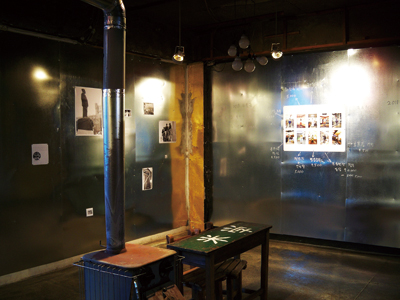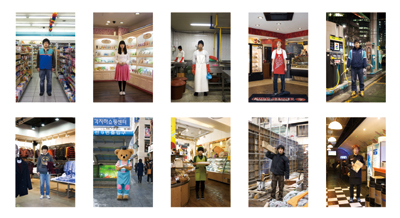
The “Inconvenient Exhibition” is composed of three series, each dealing with a specific topic, including the military camp site at Gangjeong, Poi-dong reconstruction, and college tuition. Among these, under the theme of “Poverty of Youth, College Tuition,” the first exhibition was held from Sept. 17 to 30 at Project Space LAB39. The exhibition portrayed poor students’ struggles against reality, and their efforts to make out a daily living.
“I planned this exhibition for people to realize the responsibility of my generation toward the students,” said Jang Chang, the curator of Project Space LAB39 and the producer of the “Inconvenient Exhibition.” “I wanted to stimulate college students to concentrate on and participate in their own matters.”
The exhibition is described as “inconvenient” due to the artists’ intentions to make both spectators and artists feel inconvenient by facing the harsh reality and truth behind the struggles of the underprivileged people.
Portraits of students wearing their job uniforms at their workplaces show people the reality of how student are struggling at the moment, vividly. Through the photographs, the audience also becomes aware of the students’ low hourly wages.

“Part-time job workers are like components that are part of the whole machine and help to make it work properly,” said Kim Dong-hyeok (Chung Ang University, 2),one of the exhibition’s photographers.
“I hope that students self-examine themselves, including myself, who are still in their twenties and ask themselves the question of whether we are happy or not now.”
Jang says that this exhibition is political, but “it is not about politics.”
“If art can make people pay attention to certain social issues, and the artwork can be an issue itself, it is great like Picasso’s Guernica. Art becomes history.”
“Art has the power to promote growth to solve social problems,” said Shin Hwa-young (Seoul National University, 1) who majors design and reviewed her visit to the “Inconvenient Exhibition” on Jang’s blog.
“Dogani, the Korean film that dealt with sex abuse at a school for the hearing impaired is a good example of the power of art,” said Wang So-Jeong (Spatial Design, 1). “This film draws attention to the affair that could have been buried beyond the truth.”
The “Inconvenient Exhibition” will continue in Poi-dong in October. Likewise, the work of awakening people’s consciousness toward contemporary through art pieces will continue in next year with Jang’s exhibition about the Gangjeong issue which deals with the construction of a military base in Jeju Island.
Jang Youn-hee
janet9106@ewhain.net

